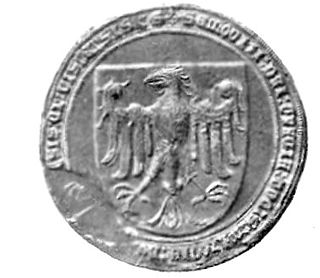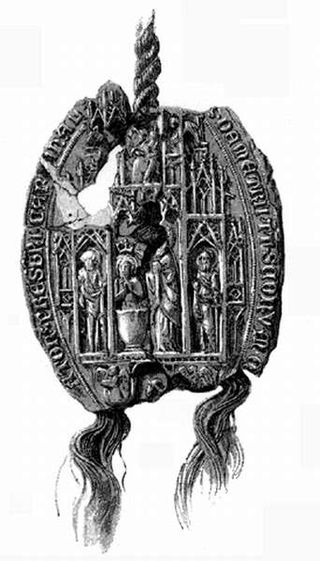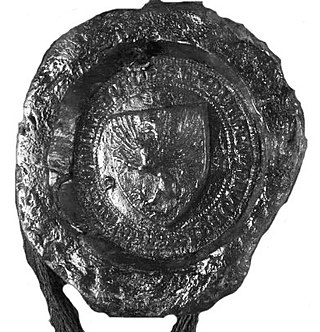
Jadwiga, also known as Hedwig, was the first woman to be crowned as monarch of the Kingdom of Poland. She reigned from 16 October 1384 until her death. She was the youngest daughter of Louis I of Hungary and Poland, and his wife, Elizabeth of Bosnia. Jadwiga was a member of the Capetian House of Anjou, but she had more close forebears among the Polish Piasts than among the Angevins.

Mary, also known as Maria of Anjou, reigned as Queen of Hungary and Croatia between 1382 and 1385, and from 1386 until her death. She was the daughter of Louis the Great, King of Hungary and Poland, and his wife, Elizabeth of Bosnia. Mary's marriage to Sigismund of Luxembourg, a member of the imperial Luxembourg dynasty, was already decided before her first birthday. A delegation of Polish prelates and lords confirmed her right to succeed her father in Poland in 1379.

Louis I, also Louis the Great or Louis the Hungarian, was King of Hungary and Croatia from 1342 and King of Poland from 1370. He was the first child of Charles I of Hungary and his wife, Elizabeth of Poland, to survive infancy. A 1338 treaty between his father and Casimir III of Poland, Louis's maternal uncle, confirmed Louis's right to inherit the Kingdom of Poland if his uncle died without a son. In exchange, Louis was obliged to assist his uncle to reoccupy the lands that Poland had lost in previous decades. He bore the title of Duke of Transylvania between 1339 and 1342 but did not administer the province.

Sigismund of Luxembourg was Holy Roman Emperor from 1433 until his death in 1437. He was elected King of Germany in 1410, and was also King of Bohemia from 1419, as well as prince-elector of Brandenburg. As the husband of Mary, Queen of Hungary, he was also King of Hungary and Croatia from 1387. He was the last male member of the House of Luxembourg.

Louis I of Orléans was Duke of Orléans from 1392 to his death in 1407. He was also Duke of Touraine (1386–1392), Count of Valois (1386?–1406) Blois (1397–1407), Angoulême (1404–1407), Périgord (1400–1407) and Soissons (1404–07).

William, known as William the Courteous, a member of the House of Habsburg and Wilhelm, was Duke of Austria from 1386. As head of the Leopoldian line, he ruled over the Inner Austrian duchies of Carinthia, Styria and Carniola as well as the County of Tyrol and Further Austria from 1396 until his death.

Siemowit IV, also known as Siemowit IV the Younger, was a Polish prince, member of the Masovian branch of the House of Piast and from 1373 or 1374 Duke of Rawa, and after the division of the paternal inheritance between him and his brother in 1381, ruler over Rawa, Płock, Sochaczew, Gostynin, Płońsk and Wizna, after 1386 hereditary Polish vassal, after 1388 ruler over Belz. During 1382–1401 he lost Wizna and during 1384–1399 and 1407–1411 he lost Zawkrze, during 1384–1399 he lost Płońsk, which was taken by the Teutonic Order.

Hermann II, Count of Celje, was a Styrian prince and magnate, most notable as the faithful supporter and father-in-law of the Hungarian king and Holy Roman Emperor Sigismund of Luxembourg. Hermann's loyalty to the King ensured him generous grants of land and privileges that led him to become the greatest landowner in Slavonia. He served as governor of Carniola, and twice as ban of the combined provinces of Slavonia, Croatia and Dalmatia, and was recognized by a treaty in 1427 as heir presumptive to the Kingdom of Bosnia. The House of Celje's rise to power culminated in achieving the dignity of Prince of the Holy Roman Empire. At the peak of his power, he controlled two thirds of the land in Carniola, most of Lower Styria, and exercised power over all of medieval Croatia. Hermann was one of the most important representatives of the House of Celje, having brought the dynasty from regional importance to the foreground of Central European politics.

Elizabeth of Luxembourg was queen consort of Hungary, queen consort of Germany and Bohemia.

Elizabeth of Poland was Queen of Hungary by marriage to Charles I of Hungary, and regent of Poland from 1370 to 1376 during the reign of her son Louis I.

The Capetian House of Anjou, or House of Anjou-Sicily, or House of Anjou-Naples was a royal house and cadet branch of the Capetian dynasty. It is one of three separate royal houses referred to as Angevin, meaning "from Anjou" in France. Founded by Charles I of Anjou, the youngest son of Louis VIII of France, the Capetian king first ruled the Kingdom of Sicily during the 13th century. The War of the Sicilian Vespers later forced him out of the island of Sicily, which left him with the southern half of the Italian Peninsula, the Kingdom of Naples. The house and its various branches would go on to influence much of the history of Southern and Central Europe during the Middle Ages until it became extinct in 1435.

Hedwig Jagiellon was a member of the Jagiellonian dynasty as a daughter of Sigismund I the Old of Poland. She was Electress of Brandenburg by marriage to Joachim II Hector, Elector of Brandenburg.

Stibor of Stiboricz of Ostoja was an aristocrat of Polish origin in the Kingdom of Hungary. He was a close friend of King Sigismund of Hungary who appointed him to several offices during his reign. For instance, between 1395 and 1401, then from 1409 to 1414 he was the Voivode of Transylvania. Stibor styled himself "Lord of the whole Vág", referring to his properties along the 409-km-long river where 15 of his 31 castles were situated.

Nicholas I Garai was a most influential officeholder under King Louis I and Queen Mary of Hungary. He was ban of Macsó between 1359 and 1375, and palatine from 1375 until his death. He was also ispán or head of a number of counties over his lifetime.

Demetrius, was a Hungarian cardinal and politician, who served as archbishop of Esztergom and bishop of Zagreb and Transylvania, and chancellor.
Nicholas Zámbó de Mezőlak was a 14th-century Hungarian treasurer and judge, who held several court offices as a loyal supporter of queens Elizabeth and Mary.

Personal union between the Kingdom of Hungary and the Kingdom of Poland was achieved twice: under Louis I of Hungary, in 1370–1382, and under Władysław III of Poland in 1440–1444. An earlier union was also accomplished by Wenceslaus III of Bohemia for a few months in 1305, although he was heavily resisted by local nobles in both kingdoms, and gave up the Hungarian crown soon after.
Hedwig of Masovia, was a Polish princess, member of the House of Piast in the Masovian branch.

Ladislaus (I) Losonci was a powerful Hungarian baron, who served as Count of the Székelys from 1373 to 1376, and Voivode of Transylvania from 1376 to 1385 and from 1386 until his death. He was a staunch supporter of Mary, Queen of Hungary after 1382. In contemporary records, he was often called Ladislaus the Elder to distinguish him from his namesake relative Ladislaus II Losonci.

Emeric (I) Bebek was a powerful Hungarian baron, who rose to prominence during the last regnal years of King Louis I of Hungary. After 1382, he was a staunch supporter of Mary, Queen of Hungary. Recognizing Sigismund's accession to the throne, he was made Judge royal, then Voivode of Transylvania. He received numerous land donations, which founded the wealth and influence of his family in the 15th century.


























